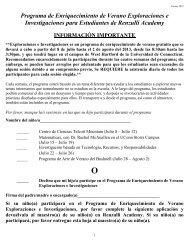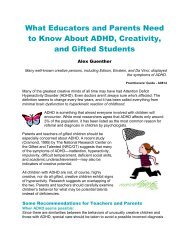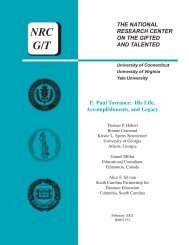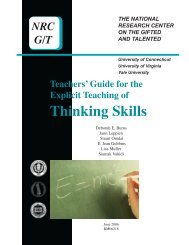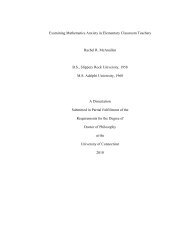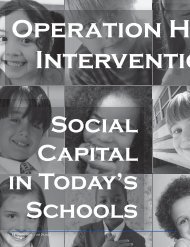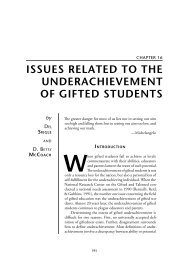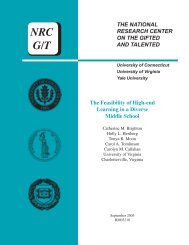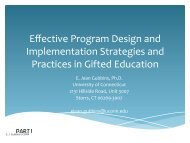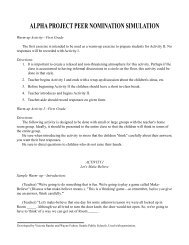Giftedness and High School Dropouts - Neag Center for Gifted ...
Giftedness and High School Dropouts - Neag Center for Gifted ...
Giftedness and High School Dropouts - Neag Center for Gifted ...
Create successful ePaper yourself
Turn your PDF publications into a flip-book with our unique Google optimized e-Paper software.
7<br />
4. <strong>Dropouts</strong> reported more behavior problems, expressed in cutting<br />
class, suspensions, higher rates of absenteeism <strong>and</strong> tardiness, <strong>and</strong><br />
trouble with the police.<br />
5. <strong>Dropouts</strong> appeared to feel more alienated, by reporting lower<br />
levels of participation in extracurricular activities <strong>and</strong> athletics.<br />
6. <strong>Dropouts</strong> were more likely to feel unpopular <strong>and</strong> looked upon as<br />
troublemakers; they were less likely to feel satisfied with or<br />
interested in school <strong>and</strong> seemed to have chosen friends who felt the<br />
same way. (Marquardt, 1987, pp. 21-22)<br />
Rumberger (1987) stated that students' reasons <strong>for</strong> leaving school varied by<br />
different social groups. For example, he found a high percentage of White <strong>and</strong> Black<br />
males cited school-related reasons <strong>for</strong> leaving school, while almost 40% of Hispanic<br />
males reported economic reasons <strong>for</strong> leaving school. Also, female dropouts mainly<br />
indicated personal reasons, such as pregnancy <strong>and</strong> marriage, as important reasons <strong>for</strong><br />
leaving school. Similarly, Grant <strong>and</strong> Sleeter (1986) proposed that separate models of<br />
dropping out need to be developed <strong>for</strong> different types of students. Hicks (1969) describes<br />
a process in which students decide to drop out of school. According to him, dropouts are<br />
not interested in school <strong>and</strong> have lower grades at the beginning stage. Out of frustration,<br />
they begin to skip school <strong>and</strong> show disruptive behavior. Due to parents' increasing<br />
negativism, the students finally decide to drop out of school.<br />
Tinto (1975) proposed that persistence should be examined in terms of the<br />
students' education. Students are "persisters" if they are continuing to work toward a<br />
degree. According to Tinto's model (see Figure 1), the decision to persist <strong>and</strong> stay in<br />
school is the result of the intersections of students' backgrounds, their goals <strong>and</strong><br />
intentions, <strong>and</strong> their interactions with the academic <strong>and</strong> social systems of their institution.<br />
Students enter an institution with differing family backgrounds, skills <strong>and</strong> abilities, <strong>and</strong><br />
prior schooling. These "pre-entry attributes" influence students' academic goals, their<br />
commitment to their education, <strong>and</strong> their commitment to the particular institution in<br />
which they are enrolled. The resulting positive or negative sense of academic <strong>and</strong>/or<br />
social "integration" with the school contributes to the students' decisions about whether or<br />
not to persist. External commitments <strong>and</strong> other external factors also influence students'<br />
decisions to continue or stop their education (Goldsmith, 1995).<br />
As many researchers have indicated, the process of deciding to drop out is long<br />
<strong>and</strong> complex. Also, researchers agree that a number of reasons are related to the dropout<br />
decision, <strong>and</strong> there is no typical single reason (Bachman, Green, & Wirtinen, 1972;<br />
Rumberger, 1987; Sadowski, 1987).




